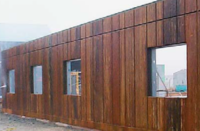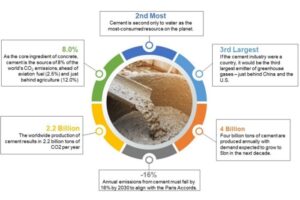If you haven’t worked on a green building yet, you will very soon. Turner Construction Co.’s 2008 “Green Building Market Barometer” reported that 83 percent of commercial real estate executives (including developers, owners, architects and engineers) are “extremely” or “very” likely to seek LEED certification for buildings planned for construction within the next three years.
The U.S. Green Building Council, which developed the LEED green-building rating system, says that there are currently more than 24,769 commercial buildings and 17,081 homes registered for LEED certification. In addition, 3,111 commercial buildings and 2,566 homes have already received certification.
That’s all good for concrete construction in general and for decorative concrete in particular, but have you considered the liability implications of building green? All construction projects have risks associated with meeting specifications and staying on schedule, but green construction throws in some twists that you should be aware of going in.
At a recent USGBC panel discussion on the legal risks of building green, attorney Keith McGlamery, of Ballard Spahr Andrews & Ingersoll LLP, stated that he thought the real estate community might face new potential liabilities by building green. “The framework of legal liability is not new. However, some of the claims within that framework are new or, at least, less familiar.”
To start, consider the very definition of what’s green. You may define it one way, and the project architect and owner may define it differently. Review the contracts and specifications very carefully to make sure you understand the specifier’s intent. Does the owner expect to achieve a certain level of green? And if so, how does that impact your portion of the job? Something as simple as using a higher-VOC sealer could affect the rating the building achieves and lead to reduced rents and loss of tax credits. Get the general contractor or owner to tell you in writing what level of sustainability they anticipate and the rating system they will use.
The entire issue of green liability is evolving, and contractors know only too well where the risk gets pushed. In a recent blog post on the National Apartment Association’s Web site, NAA state and local policy manager Scot Haislip flatly states, “In light of these new risks, owners would be wise to shift as much liability as possible to the contractor and/or consultant in their contracts. Additionally, you should double-check that their insurance policies cover losses due to failure to comply with green building requirements.”
Review for greenness
As I’ve mentioned in previous columns, manufacturers across the concrete industry are marketing their products as green. What if an architect specifies one of these products that turns out to not be as environmentally friendly as they thought? Sure, it’s the architect’s responsibility, but if it goes to court, guess who gets dragged in?
When you review the products in a specification, make sure to check the following:
Is this product as green as advertised? There are a couple of ways to check that out. One approach that is developing is GreenFormat, available from the Construction Specifications Institute – more on this later.
Is the product readily available in the quantities needed? A typical source of litigation is construction delays. If you agree to use a product, or recommend a product, that turns out to not be available, resulting in a delay, that could easily come back to bite you.
Does the product perform as well as what you are using currently? You could get stuck on either end here – you could use a durable and proven product that doesn’t meet the green standards or use something new that breaks down sooner than expected.
Make sure any specified products meet the building code requirements. The best thing would be testing by the ICC Evaluation Service that states the product does meet certain requirements. At least, check that the product states that it meets the applicable ASTM specification.
How difficult is installation? It may be the greenest product in the world, but if you can’t get it installed properly, you’ll end up with the responsibility. Also note that some green installation techniques could actually void the manufacturer’s warranty.
Are there delays inherent in the installation? For example, is curing time longer? Do the other trades need to stay off the floor longer? Either of these could lead to delays that you will get blamed for – get these waiting periods into the schedule upfront.
Checking up on a product isn’t always easy, but CSI is moving towards improving that. Set up within the framework of the CSI MasterFormat document standard (Division 3 is concrete), manufacturers list their products on GreenFormat and provide justification for their green claims including, in some cases, third-party certification. The products listed under Division 3 are limited at this time, but more are being added every day.
The federal government also has a sample specification that could help you when reviewing project specifications. The Federal Green Construction Guide for Specifiers is intended to be a comprehensive guide for obtaining green building products and construction services within the federal government. The EPA partnered with the Federal Environmental Executive and the Whole Building Design Guide to develop this model specification, also organized according to MasterFormat.
Other contract issues
The best way to avoid getting into trouble on a green project is to work with owners, developers, architects and general contractors who have experience with the process. And you too will need the experience and education to at least be able to understand what is being discussed. Don’t get stuck by underestimating your commitment. LEED projects invariably demand additional paperwork to justify green practices. In some cases, you could be required to adopt new internal quality assurance procedures.
Look for, or ask for, a statement in your contracts that excludes third-party beneficiaries. This could, for example, prevent a tenant from suing you when the building doesn’t meet their expectations – say for reduced energy usage or the amount of sunlight.
If your work is going to lead to green points, make sure you understand which points you are responsible for and very specifically how the points are achieved. Are you expected to recycle everything on the job site? Use products with recycled content? Eliminate all products with any VOCs? Also, beware of clauses that could result in loss of incentive bonuses if certain green levels aren’t reached.
Insurance coverage is another potential problem. Some insurance companies exclude certain green practices or charge more. Others are working to reduce their customers’ risks. For example, ACE USA’s environmental risk group complements a contractor’s insurance policy with the ACE Green CPL program, a green-specific insurance program that helps clients assess and proactively manage environmental impacts and liabilities.
Green projects can be a growing source of business for decorative concrete. The risks aren’t really greater than for any other construction project, but you should understand where the potential hooks are and how to avoid them.
Notes on Avoiding Litigation
For a good overview of the legal issues involved with building green, contact the National Association of Home Builders to get a copy of “Before You Build Green: A Primer on Avoiding Liability Pitfalls.” This brochure covers marketing, contracts, warranties, compliance with laws, training and installation. It recommends that contractors take steps to reduce the risk that a green building project could result in litigation.
www.nahb.org
(800) 368-5242 ext. 8291
Other Resources
Federal Green Construction Guide for Specifiers | www.wbdg.org
Turner Construction Co.’s 2008 “Green Building Market Barometer” | www.turnerconstruction.com
Federal Green Construction Guide for Specifiers | www.wbdg.org
USGBC panel discussion on the legal risks of building green | www.usgbcny.org
GreenFormat, from the Construction Specifications Institute | www.greenformat.com
“Green Legal Liability,” by NAA state and local policy manager Scot Haislip | www.naahq.org















